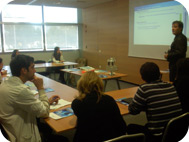LabCluster
PARIS spécial PROTEOMIQUE
|
|
La participation est gratuite sur inscription et réservée aux personnels de laboratoire de recherche Il est possible de participer à la totalité de l'événement ou seulement à une ou plusieurs conférences. |
|||||
| Cliquez ici pour vous inscrire |
|
||||
Programme :
| |
8h30 | Coffee and Pastries Welcome participants 9h00-9h30 | LUNAPHORE | Profiling the tumor microenvironment with fully automated spatial biology Novel technologies that deliver single-cell data have shed new light on biological processes and brought many exciting findings into life science research. Easy access to omics technologies is needed to push the boundaries of research and fill the high demand for it. Lunaphore aims to fill that gap and bring spatial context to single-cell assays. Here, we will show how to generate reproducible spatial data with COMET™, a universal hyperplex solution for high-throughput spatial multimers. The COMET™ platform performs sequential immunofluorescence (seqIF™) assays to detect 40 protein targets per automated run. Guided workflow optimization and flexibility of the system to use the off-shelf reagents allow fast and easy adoption of the methodology in every laboratory, enabling researchers to explore the cellular microenvironment from assay development to cohort analysis in a few weeks. Here, we will also present our new fully automated, spatial multiomics workflow that integrates the simultaneous detection of RNA, with RNAscope™ HiPlex, and protein, with seqIF™, on the same tissue section at the single-cell level. 9h30-10h00 | NANOSTRING| Spatial Proteomics innovative solutions to unravel complex biology Join us at Centre de Recherche Cordeliers to learn how NanoString Technologies’ innovative platforms can provide spatial context to your proteomics work. The GeoMx® Digital Spatial Profiler (DSP) can interrogate multicellular tissue samples for more than 570 proteins which can be co-detected with the whole transcriptome. Thanks to its multi-modal approach for true single-cell segmentation, the CosMx™ Spatial Molecular Imager (SMI) allows you to view 64 proteins with subcellular resolution. Participate in this Labcluster event and discover how the GeoMx DSP and CosMx SMI are revolutionizing research in fields such as cancer, immunology, and neuroscience. To know more, visit : www.nanostring.com | Coffee Break 10h30 -11h00 | LEICA MICROSYSTEMS | The power of Spatial Biology: Identify targets, collect and analyze Within a tissue, individual cells of the same type may behave differently based on variations in their microenvironment. Transcriptomics and proteomics methods such as mass spectrometry sequencing typically only provide small snapshots of information that are often challenging to piece together. In contrast, microscopy enables researchers to look at the bigger picture and track proteins and other biomarkers at a single cell level to better understand the whole tissue landscape. Multicolor imaging (also known as multiplexing) enables researchers to use multiple fluorophores within the same sample, allowing related components and processes to be observed in parallel. This adds more context to your observations and consequently provides more meaningful results. Since multiplexing requires the use of multiple fluorophores to stain the various markers of interest, choosing the right fluorophore combination for your experiment is critical and minimizing crosstalk is key. However, traditional methods to reduce crosstalk are slow and can involve tedious manual adjustments or a high degree of technical microscopy knowledge. Normal and diseased tissues can be mapped to reveal the spatial relationships of 60+ biomarkers in a single tissue section. This antibody-based “hyperplexed” workflow to examine spatial cell biology and function is enabled using the Cell DIVE Multiplexed Imaging Solution. Sometimes, specific areas of a sample need to be isolated for downstream analysis or to decipher the details within a specific region, free of contamination. For example, in cancer biology there are distinct molecular differences between tumor and non-tumor regions, as well as in the tumor itself. These can only be deciphered by isolating specific, minute sections of these regions. Laser MicroDissection (LMD), or Laser Capture Microdissection (LCM), is a method designed to isolate and dissect target cells or entire areas of tissue from a wide variety of samples 11h00-11h30| OLINK PROTEOMICS | From bench to Clinics : Next generation Multiplex Protein measurement to accelerate Precision Medicine Join us to hear more about the Proximity Extension Assay (PEA) technology driving Olink’s protein panels and how scientists around the world use PEA to accelerate fundamental and clinical research and increase our understanding of human biology. During the presentation you will find out more about Olink’s Swedish roots and heritage and how PEA can be scaled, from the reliable detection of up to ~5400 proteins per sample to disease-and biology-focused panels, as well as flexible options enabling you to design your own 21 protein custom panel, all from just a few microliters of sample. We look forward to meeting you on the 19th of March and discussing how PEA can accelerate your research! 11h30-12h00| AKOYA BIOSCIENCES | Scaling up deep Spatial Phenotyping with a novel Omics approach for Biomarker Discovery Text to come Stands en libre accès toute la matinée : Lunaphore, Nanostring, Leica Microsystems, Olink Proteomics, Akoya Biosciences, ThermoFisher Scientific ••••••••••••••••••••••••••••••••••••••••••••••••••••••• ••••••••••••••••••••••••••••••••••••••••••••••••••••••• |
||
|
Stands de démonstration et d'information en libre accès. Venez nous rencontrer. |
|||

| Le nombre de places étant limité, il est fortement conseillé de s'inscrire à l'avance en cliquant ici |
|
|||
| Pour toute question ou demande d'information, cliquez ici | |
![]()



